Varied difficulty levels in TS Inter 1st Year Zoology Model Papers and TS Inter 1st Year Zoology Question Paper May 2019 cater to students with diverse academic strengths and challenges.
TS Inter 1st Year Zoology Question Paper May 2019
Time: 3 Hours
Max. Marks: 60
General Instructions:
Note : Read the following instructions carefully :
- Answer all the questions of Section – ‘A’. Answer any six questions in Section – ‘B’ and answer any two questions in Section – ‘C’.
- In Section – ‘A’ questions from Sr Nos. 1 to 10 are of Very Short Answer Type. Each question carries two marks. Every answer may be limited to 5 lines. Answer all these questions at one place in the same order.
- In Section – ‘B’ questions from Sr. Nos. 11 to 18 are of Short Answer Type. Each question carries four marks. Every answer may be limited to 20 lines.
- In Section – ‘C’, questions from Sr. Nos. 19 to 21 are of Long Answer Type. Each question carries eight marks. Every answer may be limited to 60 lines.
- Draw labelled diagrams wherever necessary in Sections – B and C.
Section – A (10 × 2 = 20)
Note : Answer all the questions in 5 lines each.
Question 1.
What does ICZN stand for ?
Answer:
ICZN stands for ‘International Code of Zoological Nomenclature which specifies the mandatory rules to be followed for the naming animals by International congress (ICZ) in 1898.
Question 2.
Why are incinerators used in hospitals ?
Answer:
Disposal of hospital wastes that contain disinfectants, harmfull chemicals and also pathogenic micro-organisms incinerators are used in hospitals.
Question 3.
Distinguish between milt and spawn.
Answer:
During amplexus, the mass of eggs and the mass of sperms released by the female and male are called spawn and milt.
Question 4.
What is the haematocrit value ?
Answer:
The percentage of total volume occupied by RBCs in blood is called haematocrit value.
![]()
Question 5.
Distinguish between brown fat and white fat.
Answer:
White fat : It is the predominant type in the adults, the adipocyte has a single large lipid droplet. White fat is matabolically not active.
Brown fat : It is found in foetus and infants. Adipocyte of Brown fat has several small ‘lipid droplets’ and metabolicaly active and generates heat to maintain body temperature required by infants.
Question 6.
What is the strongest cartilage ? In which regions of the human body, do you find it ?
Answer:
The fibrous cartilage is the strongest of all types of cartilages. It occurs in the intervertebral discs and pubic symphysis of the pelvis.
Question 7.
Distinguish between proter and opisthe.
Answer:
During transverse binary fission in Paramecium two daughter individuals are formed. The anterior one is called proter and the posterior is called opisthe.
Question 8.
What do you mean by parasitic castration ? Give one example.
Answer:
Some parasites cause the degeneration of gonads of the host making it sterile. This effect is called parasitic castration, eg: Sacculina (root headed barnacle, a crustacean) causes the degeneration of ovaries in the crab Carcinus maenas.
Question 9.
Distinguish between amphids and phasmids.
Answer:
Amphids : These are the cuticular depressions present on the lips surrounding the mouth in the nematodes such as Aphasmidia animals and serve as Chemoreceptors.
Phasmids : These are the well developed sensory organs and they occur in some nematodes such as phasmidia animals.
Question 10.
Draw a labelled diagram of T.S of flagellum.
answer:

![]()
Section – B (6 × 4 = 24)
Note : Answer any six questions in 20 lines each.
Question 11.
What are the adverse effects of tobacco ?
Answer:
Effect : Smoking increases the carbon monoxide (CO) level and reduces the oxygen level in the blood. Nicotine stimulates the adrenal gland to release adrenaline and nor-adrenajine into blood.
These hormones raise the blood pressure and increase the heart rate. Smoking is associated with bronchitis, emphysema, coronary heart disease, gastric ulcer and increases the incidence of cancers of throat, lungs, urinary bladder etc. Smoking also paves the way to hard drugs. Yet smoking is very pravalent in society, both among young and old. Tobacco chewing is associated with increased risk of cancer of the oral cavity.
Question 12.
What are the chief characters of the crustaceans ?
Answer:
- This includes prawns, crabs, lobsters, cray fishes etc.
- Mostly marine, a few are fresh water and some are adapted to terrestirial life.
- In most species, head and thorax fuse to form cephalo thorax.
- Cephalic appendages are five pairs – first antennae (antennules) second antennae, mandibles, first maxillae and second maxillae.
- Thoracic and abdominal appendages, are typically biramous.
- Respiration is by gills.
- Excretory organs are green glands or antennal glands.
- Sense organs include statocysts, compound eyes and antennae.
- Gonopores are paired.
- Development is direct or indirect involving several larval stages. Basic larva is nauplius.
Ex : Pqlaemon (Prawn) ; Cancer (Crab).
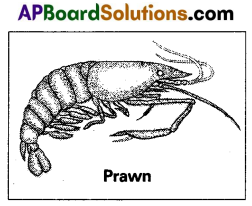
Question 13.
Compare and contrast cartilaginous and bony fishes.
Answer:
| Cartilaginous fishes | Bony fishes |
| 1. These are marine farms. | 1. These are live in all kinds of aquatic habits. |
| 2. Endoskeleton made by cartilaginous. | 2. Endoskeleton made by bone. |
| 3. Body covered by plocoid scales. | 3. Body covered by cosmoid, ganoid, cycloid or ctenoid scales. |
| 4. Caudal fin is heterocercal. | 4. Caudal fin is homocercal. |
| 5. Operculum absent. | 5. Operculum present. |
| 6. Air bladder absent. | 6. Air baldder present. |
| 7. Gills are lamelliform and are five to seven in each side. | 7. Gills are filamentous and are four in each side. |
| 8. These are ureotelic. Ex : Scoliodon, Pristic, Torpedo. | 8. These are mostly ammonotelic. Ex: Catla, Labeo, Exocetus, Hippocampus. |
Question 14.
Explain ‘Rivet Popper’ hypothesis.
Answer:
What if we lose a few species? Will it affect man’s life? Paul Ehrlich experiments Rivet popper, hypothesis, taking an aeroplane as an ecosystem, explains how removal of one by one ‘rivets’, (species of an ecosystem) of various parts can slowly damage the plane (ecosystem) shows how important a ‘species’ is in the overall functioning of an ecosystem. Removing a rivet from a seat or some other relatively minor important parts may not damage the plane, but removal of a rivet from a part supporting the wing can result in a crash. Likewise, removal of a ‘critical species’ may affect the entire community and thus the entire ecosystem.
![]()
Question 15.
Give an account of glandular epithelium.
Answer:
Glandular epithelium : Some of the columnar or cuboidal cells the get specialised for the productions of certain secretions, form glandular epithelium. The glands are of two types.
Unicellular glands : Consisting of isolated glandular cells such as goblet cells of the gut.
Multicellular glands : Consisting of clusters of cells such as salivary glands. On the basis of the mode of pouring of their secretions, glands are divided into two types namely exocrine and endocrine glands.
Exocrine glands : These glands provided with ducts secrete mucus, saliva, earwax, oil, milk, digestive enzymes etc.
Endocrine glands : These glands are the ductless and their products are hormones, which are carried to the target organs by blood.
Based on the mode of secretion, Exocrine glands are further divided into three types :
- Merocrine glands : Which release the secretoiy granules without the lost of other cellular material. Ex : Pancreas.
- Apocrineglands : The apical part of the cell is pinched off along with the secretoiy product. Ex : Mammary glands.
- Holocrine glands : The entire cell disintegrates to discharge the contents. Ex : Sebaceous gland.
Question 16.
What are the deletorious effects of depletion of ozone in the stratosphere ?
Answer:
The depletion of ozone is particularly marked over the Antarctic region. This has resulted in the formation of a large area thinned ozone layer commonly called as the ‘ozone hole’.
UV radiation with wavelengths shorter than that of UV-B, are almost completely absorbed by Earth’s atmosphere, provided that the ozone layer is intact. But UV-B damages DNA and may induce mutations. It causes ageing of skin, damage to skin cells and various types of skin cancers. In human eye, cornea absorbs UV-B radiation and a high dose of UV-B causes inflammation of cornea called snow – bindness, cataract, etc., such exposure may permanently damage the cornea.
Question 17.
Give an account of pseudopodia.
Answer:
Locomotion in protozoans is performed by cellular extensions such as pseudopodia are found in rhizopods organisms. The pseudopodia are temporary extensions of cytoplasm that develop in the direction of the movement. These temporary structures are useful to move on the s’ubstratum as our legs do, hence the name ‘pseudopodia’. There are four kinds of pseudopodia in protozoans.

- Lobopodia : blunt + finger like Pseudopodia. Ex : Amoeba, Entamoeba.
- Filopodia : fiber like pseudopodia contain ectoplasm. Ex : Euglypha
- Reticulopodia : net like pseudopodia. Ex : Elphidium.
- Axopodia or heliopodia : Sun ray-like pseudopodia. Ex : Actinophrys.
![]()
Question 18.
Draw a neat, labelled diagram of Ommatidium.
Answer:

Section – C (2 × 8 = 16)
Note : Answer any two questions in 60 lines each.
Question 19.
Describe lake as an ecosystem giving examples for the various zones and the biotic components in it.
Answer:
Deep water lakes contain three distinct zones namely :
i) Littoral zone,
ii) limnetic zone and
iii) profundal zone.
Littoral Zone : It is the shallow part of the lake closer to the shore. Light penetrates up to the bottom. It is euphotic (having good light) has rich vegetation and higher rate of photosynthesis, hence rich in oxygen.
Limnetic Zone : It is the open water zone away from the shore. It extends up to the effective light penetration level, vertically. The imaginary line that separates the limnetic zone from the profundal zone is known as zone of compensation/compensation point light compensation level. It is the zone of effective light penetration. Here the rate of photosynthesis is equal to the rate of respiration. Limnetic zone has no contact with the bottom of the lake.
Profundal Zone : It is the deep water area present below the limnetic zone and beyond the depth of effective light penetration. Light is absent. Photosyntheti’c organisms are absent and so the water is poor in oxygen content. It includes mostly the anaerobic organisms which feed on detritus.
The organisms living in lentic habitat are classified into pedonic forms, which live at the bottom of the lake and those living in the open waters of lakes, away from the shore vagetation are known as limnetic forms.
Biota (animal and plant life of a particular region) of the littoral zone : Littoral zone is rich with pedonic flora (especially up to the depth of the effective light penetration). At the shore proper emergent vegetation is abundant with firmly fixed roots in the bottom of the lake and shoots and leaves are exposed above the level of water. These are amphibious plants. Certain emergent rooted plants of littoral zone are the cattails (Typha), bulrushes (scirpus) arrowheads (sagittaria),. Slightly deeper are the rooted plants with floating leaves, such as the water lilies (Nymphaea), Nelumbo, Trapa, etc., still deeper are the submerged plants such as Hydrilla – Chara, potamogeton, etc…. The free floating vegetation includes pistia, wolffia, Lemna (duck weed), Azolla, Eichhomia etc.
The phytoplankton of the littoral zone composed of diatoms. (Coscinodiscus, Nitzschia, etc) green algae (Vblvox, spirogyra etc), euglenoids (Euglena, phacus, etc) and dinoflagellates (Gymnodinium, Cystodinium, etc….)
Animals, the consumers of the littoral zone, are abundant in this zone of the lake, these are categorized into zooplankton, neuston, nekton, periphyton, and benthos. The Zoo-plankton of the littoral zone consists of water fleas such as Daphnia, rotizers and ostracods.
The animals living at the air-water interface constitute the neuston. They are of two types. The epineuston and hyponeuston. Water striders (Gerris), beetles, water bugs (Dineutes) form the epineuston/supraneuston and the hyponeuston/infraneuston includes the larvae of mosquitoes.
The animals such as fishes, amphibians, water-snakes, terrapins, insects like water scorpion (Ranatra), back swimmer (Notonecta), driving beetles (Dytiscus), capable of swimming constitute the nekton.
The animals that are attached to / creeping on the aquatic plants, such as the ‘water snails’, nymphs of insects, bryozounsa, turbellarians, hydras etc, constitute the periphyton.
The animals that rest on or move on the bottom of the lake constitute the ‘benthos’, e.g.: red annelids, chironomid larvae, Cray fishes, some isopods amphipods, clams etc.
Biota of the limnetic zone: Limnetic zone is the largest zone of a lake. It is the region of rapid variations of the level of the water, temperature, oxygen availability etc., from time to time. The limnetic zone has autotrophs (photosynthetic plants) in abundance. The chief autotrophs of this region are the phytoplankton such as the euglenoids, diatoms, cyanobacteria, dinoflagellates and green algae. The consumers of the limnetic zone are the zooplanktonic organisms such as the copepods, Fisher frogs, water snakes etc., form the limnetic nekton.
Biota of the profundal zone : It includes the organisms such as decomposers (bacteria), chironomid larvae, Chaoborus (phantom larva), red annelids, clams etc., that are capable of living in low oxygen levels. The decomposers of this zone decompose the dead plants and animals and release nutients which are used by the biotic communities of both littoral and limnetic zones.
The lake ecosystem performs all the functions of any ecosystem and of the biosphere as a whole. i.e., conversion of inorganic substances into organic material, with the help of the radiant solar energy by the autotrophs, consumption of the autotrophs by the heterotrophs; decomposition and mineralization of the dead matter to release them back for reuse by the autotrophs (recycling of minerals).
![]()
Question 20.
Describe the structure and life cycle of Ascaris lumbricoides with the help of a neat and labelled diagram.
Answer:
Ascaris lumbricoides is commonly called the common round worm. It lives in the small intestine of man, more frequently in children. It is cosmpolitan in distribution. Mode of infection is through contaminated food and water. Infective stage is the embryonated egg with the 2nd stage rhabditiform larva.
Structure : Sexes are separate and the sexual dimorphism is distinct. In both males and females the body is elongated and cylindrical. Mouth is present at the extreme anterior end and is surrounded by three chitinous lips close to the mouth. Mid ventrally there is a small aperture called excretory pore.
Male : It has a curved posterior end which is considered the tail. The posterior end possesses a cloacal aperture and a pair of equal sized chitinous pineal spicules or pineal setae which serve to transfer the sperms during copulation.
Female : It has a straight posterior end, the tail. The female genital pore or vulva is present mid ventrally at about one third the length from fnouth. The anus is present a little in front of the tail end.
Life history : Copulation takes place in the small intestine of man. After copulation, the female releases approximately two lakh eggs per day. Each egg is surrounded by a protein coat with rippled surface. Hence the eggs of Ascaris are described as mammillated eggs. The protein coat is followed by a chitinous shell and a lipid layer internally. These eggs come out along with faecal matter. In the moist soil, development takes place inside the egg so that the 1st stage rhabditiform larva is produced. It undergoes the 1st moulting and becomes the 2nd stage rhabditiform larva which is considered the stage infective to man. They reach the alimentary canal of man through contaminated food and water.
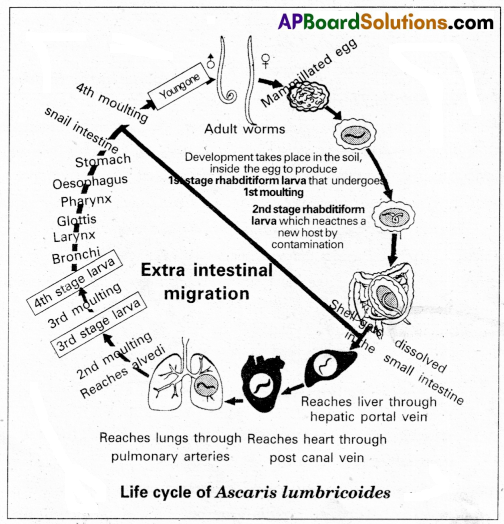
In the small intestine, the shell gets dissolved so that the 2nd stage larva is released. Now it undergoes extra intestinal migration. First it reaches the liver through the hepatic portal vein. From there it reaches the heart through the post caval vein. It goes to the lungs through the pulmonary arteries. In the alveoli of lungs it undergoes the 2nd moulting to produce the 3rd stage larva. It undergoes the 3rd moulting so that the 4th stage larva is produced in the alveoli only. It leaves the alveoli and reaches the small intestine again through bronchi, trachea, larynx, glottis, pharynx, oesophagus and stomach. In the small intestine. It under goes the 4th and final moulting to become a young one which attains sexual maturity with in 8 to 10 weeks.
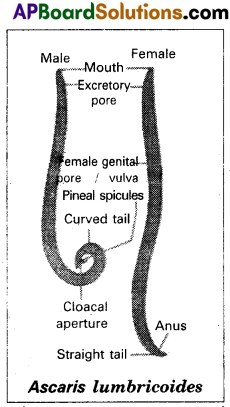
![]()
Question 21.
Describe the digestive system of cockroach with the help of a neat labelled diagram.
Answer:
The digestive system of cockroach consists of an alimentary canal and tfie associated glands. The preoral cavity surrounded by the mouth parts, is present in front of the mouth. The hypophaiynx divides it into two chambers called cibagium (anterior) and salivarium (posterior).
Alimentary canal : The alimentary7 canal of cockroach is a long tube and is coiled at some places. It extends between the mouth and the anus. It is divided into three regions namely foregut of stomodaeum, midgut or mesenteron and hindgut are internally lined by ectoderm. The mesenteron is lined by the endodermai cells.
Forgut or stomodaeum : The foregut includes pharynx oesophagus, crop and gizzard. It is internally lined by a chitinous cuticle. Mouth opens into the pharynx, which in turn leads into a narrow tubular oesophagus. The oesophagus opens behind into a thin walled distensible sac called crop. The crop serves as a reservoir for storing food. Its outer surface is covered by a network of tracheae. Behind the crop there is a thick walled muscular proventriculus or gizzard.
The chitinous inner living of the gizzard has six powerful teeth, which form an efficient grinding apparatus. Behind each tooth is a hairy pad, which bears backwardly directed bristles. Among these plates, food is throughly ground into fine particles. These food particles are filtered by the bristles. The gizzard thus acts both as a grinding mill and also as a sieve. There is a membranous projection of the gizzard into the mesenteron in the form of a funnel called stomodeal valve. This valve prevents the entry (regurgitation) of food from the mesenteron back into the gizzard.
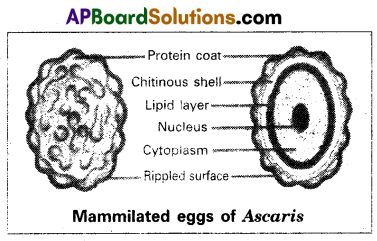
Midgut (mesenteron or ventriculus) : The midgut is a short and narrow tube behind the gizzard. It is also called mesenteron or ventriculus. Between the ventriculus and the gizzard, arising from ventriculus there are six to eighth finger like diverticule called hepatic caecae.
They are helpful in digestion and absorption of the digested food materials. Ventriculus is functionally divided into an anterior secretory part and a posterior absorptive part.
The secretory part of the ventriculus has many gland cells and it secretes several enzymes. The ‘bolus’ of food in the mesenteron is enveloped by a chitinous and porous membrane called peritrophic membrane, which is secreted by the funnel like stomodeal valve of the gizzard. Digested food is absorbed into the food through the peritrophic membrane in the posterior absorptive region of the ventriculus. The peritrophic membrane protects the wall of the ventriculus from hard food particles in the food. The opening of the ventriculus.into the hindgut is controlled by a.sphincture muscle. It prevents entry of undigested food from the hindgut into the midgut.
Hindgut or proctodaeum : The hindgut is a long coiled tube, consisting of three regions namely ileum, colon and rectum. It is interanlly lined by chitinous cuticle. The ileum that lies behind the mesenteron is a short tube. Six bundles of fine yellow, blind tubules called Malpighian tubules open into the ileum near the junction of mesenteron and ileum. Malpighian tubules are excretory in function.- Ileum collects uric acid from the malpighian tubules and undigested food from the mesenteron. Ileum opens behind into a long coiled tube called colon. Colon leads into a short and wide rectum which opens out through the anus. Rectum bears on its inner side six longitudinal chitinous folds called rectal papillae. They are concerned with the reabsorption of water from the undigested food.
Digestive gland : The digestive glands associated with the alimentary canal of cockroach are salivary glands, hepatic caecae and glandular cells of the mesenteron.
Salivary glands : There is a pair of salivary glands attached to the vetrolateral sides of the crop, one on each side. Each salivary gland has two lobes. Each lobe of salivary gland has many lobules called acini. Each acinus is a group of secretory cells called zymogen cells with a small ductule. The ductules of both the lobes of a salivary gland unite to form a common salivary duct on each side.
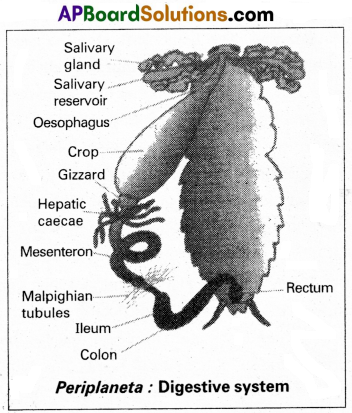
The two common salivary ducts are joined to form the median salivary duct. Between the two lobes of a salivary gland of each side is a sac called Salivary receptacular duct or common reservoir duct. The midious salivary duct opens into the common receptacular duct. Later these two form an efferent salivary duct. The efferent salivary duct opens at the base of the hypopharynx. Acinar cells secrete saliva, which contains starch digesting enzymes such as amylase.
Hepatic caecae : The hepatic caecae are also termed midguts caecae. They contain secretory and absorptive cells.
Glandular cells of the mesenteron : The glandular cells of the mesenteron secrete enzymes such as maltase, invertase, proteases and lipase.